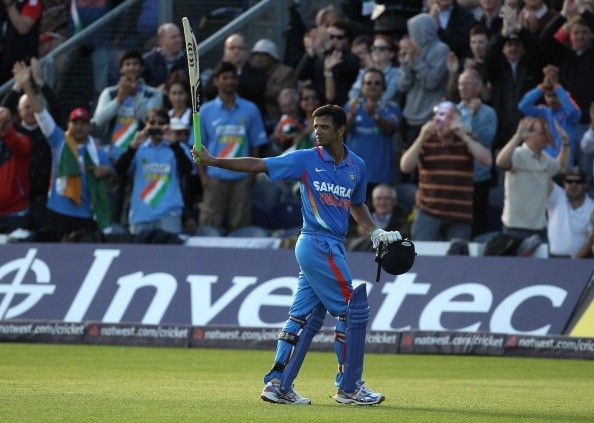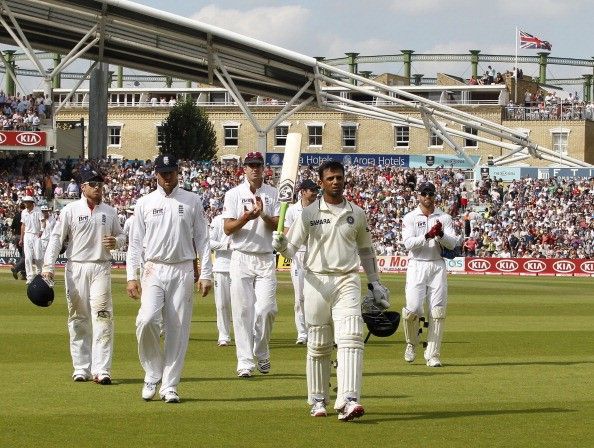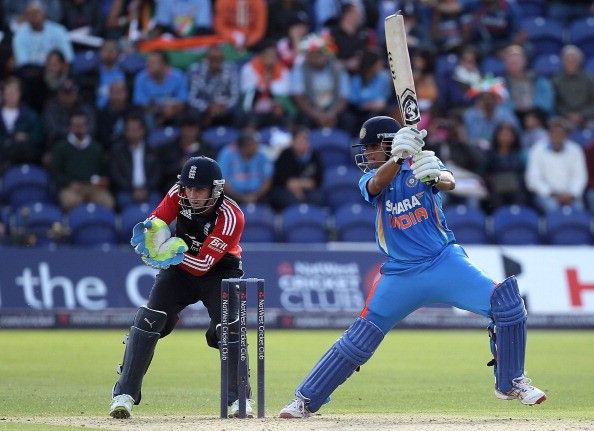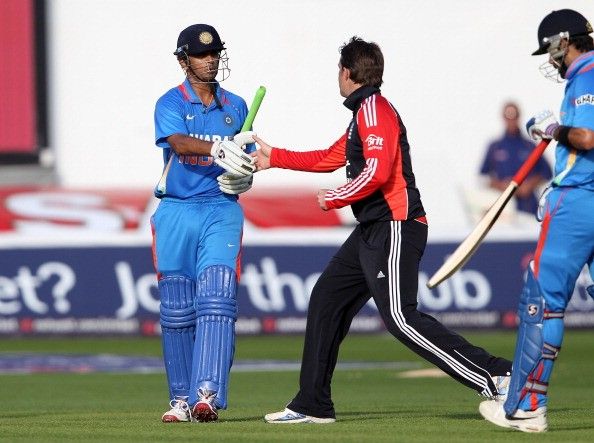
#SKFlashback: Rahul Dravid's final hurrah in ODIs
There is a famous quote on cricket, by poet Edmund Blunden, which goes: “Cricket to us was more than play, it was worship in the summer sun.”
If there can ever be cricketer who personifies that quote, it has to be Rahul Dravid. He was every captain’s dream, the man who always put the team first. Dravid is grace, modesty and determination snowballed into a single man.
There can’t be many things on a cricket field that Dravid hasn’t done – open the batting, batting in the middle order, blunting the new ball, playing aggressive cricket, keeping wickets, standing in the slips, even sending down a couple of overs and getting the wicket of Saeed Anwar and Gary Kirsten.
On this day – September 16 – four years ago, Rahul Dravid played his last One Day International match, against England at Cardiff.
Before 2011, Dravid last played an ODI in 2009, in a match in the ICC Champions Trophy. Since then, he was never picked for the 50-over format before this game against England. Dravid realised that the youngsters needed to be given a chance, and he happily stepped aside. Since then India played 12 ODI series and won seven of them quite comfortably. Though it wasn’t the perfect result, it was still an acceptable one for the team which had a healthy mix of seniors and youngsters.
Though India won the World Cup in 2011, the fact remained that India had been playing at home for quite a while, and everybody was waiting with bated breath to see them perform overseas. After a close-fought 3-2 ODI win in West Indies, the Indian team travelled to England, determined to make history once again. A four-match Test series was scheduled first, and Dravid – who was regular in the Test side - was ready to play England in their backyard.
A Disastrous Tour of England
It is widely accepted that India’s overseas troubles began the moment Zaheer Khan walked off the pitch on the first day of the first Test match at Lord’s. India watched their best bowler limp away as Kevin Pietersen joined Matt Prior to take England to 474. Dravid scored a gritty century, but India were never truly in the match, and the Test – which was incidentally the 2000th Test match – ended in a humiliating defeat for India.
The next two matches were not any better. Dravid scored another century in the second Test, but England won by 319 runs, dismissing India for 158 in the second innings in just over a session. Not even Dravid’s impeccable batting could save India in the third Test, as England won by an innings after declaring their first innings at a score of 710/7.
By the time of the last Test, India was playing for pride. They needed an opener desperately, and there was nobody available. Everybody looked pleadingly at Dravid, and he agreed. Even after asking a legend of the game to give up his favourite position, the Indian bowlers did not grow a spine as England cruised to 591/6 declared.
India responded with 300 all out, with Dravid carrying the bat, scoring 146*. It would be the first – and only – time India made 300 in the Test series. Even after almost a full day’s play was lost to rain, India managed to lose by an innings, underlining their helplessness overseas. India’s fierce era had come to an end, and only Dravid could walk away with some dignity.
A surprise inclusion and a familiar acceptance
Once the Test series had ended, there would a solitary T20I and a 5 match ODI series. Tendulkar had asked for a rest, and Yuvraj and Harbhajan were out injured. Sehwag and Sachin were included, but there doubts over how many matches they would play. So apart from MS Dhoni, India had virtually no one with experience in playing in English conditions. After the drubbing they got in the Test series, the Indian selectors had to act fast, or they would surely be subjected to another humiliating series loss.
It was a bolt from the blue when Dravid was selected for both the ODI and T20 squads. Dravid, who was least expecting it, confessed that he had no intention of playing ODIs after 2009 and had failed to mention to the BCCI that he wanted to concentrate only on Tests. But Dravid did not shy away from his responsibility. He understood that he was in charge of leading India’s transition from the old to the new. He accepted his position.
But Dravid made a surprise announcement himself. He declared that he would retire from ODIs and T20Is after that series.
From bad to worse – the setup to the final match
Dravid’s announcement stunned nearly everyone in the cricketing world and over the next few days, there were tweets being sent, photos being shared and heartfelt tributes being given. Talks about Dravid’s selflessness and his passion for the game were everywhere, but he paid it no mind. His focus was on one thing only, and it was seeing off the English ODI team.
India lost the only T20I despite a sparkling 65 by Ajinkya Rahane. Dravid made the most of his time in the middle as he slammed three consecutive sixes. The first ODI was washed out, with India in a good position after having reduced England to 27-2 chasing 274 runs.
The second ODI showed India’s ability to collapse spectacularly. After rain reduced the match to 23 overs, India went from 109-2 in 14 overs to 187/8 in 23. Dravid scored 32 off 31, the third highest score. Apart from Suresh Raina, India’s last 7 batsmen managed 27 runs between them. England chased it down easily.
The third ODI was as one-sided as they come. India limped to 234-7 in their 50 overs after Dravid was run-out while ball watching. MS Dhoni’s watchful innings made sure India batted the full quota of overs, but the knock was in vain. England got a reduced target of 218 runs in 43 overs and they smoothed it over nicely.
The fourth ODI – Dravid’s penultimate one – was not short of excitement. After India finished strongly on 280/5 – Dravid scored 19 – England were given several revised targets. Finally, with England on 270/8, the rain poured down and the match was declared a tie.
England had won the series 2-0, and India had to play for pride in the last ODI, which would be Dravid’s last.
Rahul Dravid’s last appearance in coloured clothing
Much like most of India’s summer, the match began poorly. After a quick 50-run partnership between the openers, both were dismissed one after the other which left India at 57/2. Dravid and the young Virat Kohli were at the crease, and India needed to get out of trouble fast. Dravid had to use his entire wealth of experience and steer India out of trouble – something he was an expert on.
It began with a soft nudge to the covers, but the timing was such that it travelled to the boundary. Two overs later, Dravid’s trademark cut peppered the square boundary. Dravid had read the pitch well and had begun to adjust. He took the singles hard and the doubles harder, at times pushing his younger partner to the limit.
Kohli responded beautifully, allowing Dravid to shepherd the team, occasionally hitting boundaries to keep the run-rate intact. Such was Dravid’s patience and skill that he went 20 overs without scoring a single boundary, but his strike rate was still above 85.
Dravid brought up his 50 off 62 balls and continued to let Kohli do all the striking. He helped him in between, with a beautiful chip over extra cover that went to the boundary in one bounce. Steve Finn pitched one just short and Dravid launched it between mid-off and extra cover. He held the pose for a second and admired it go. It would be his last boundary in ODIs.
Two balls later, Dravid was dismissed. He had tried to hit Swann over midwicket, but the ball spun past his bat and clipped the off stump. Dravid walked off to tumultuous applause and handshakes from the Englishmen. After playing 79 balls for a patient 69, Dravid had perished trying to increase the scoring rate, because that was what the team required.
Farewell to a legend
For a guy who is mostly remembered for his slow rate of scoring and making the bowlers toil, it is quite remarkable that Dravid has more than 10000 ODI runs at a strike rate of close to 72. He is still in the Top 10 all-time run scorers in ODIs – at 9th – and is the third highest for India. He has been involved in two 300-run partnerships in the game – the only cricketer to do so.
Dravid’s contribution to ODI cricket is more than his batting, fielding or even his wicket-keeping. His mere presence gave the team a calm and composed look. His gentlemanly behaviour and modesty are the stuff of legends. His attitude in the field proved that a player did not need to sledge to get under the opposition’s skin.
Dravid often jokes that the future would only remember him as the guy who played with Sachin Tendulkar. But Dravid is much, much more. He is the embodiment of India’s cricketing spirit. When Dravid left the field on 16 September 2011, he left behind a void that could never be filled.



